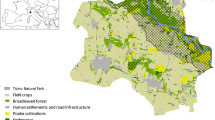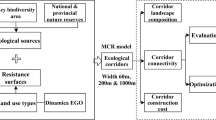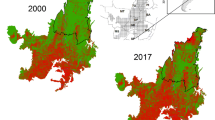Abstract
Farmland reforestation can contribute substantially to ecological restoration. Previous studies have extensively examined the ecological effects of farmland reforestation, but few of them have investigated the spatiotemporal responses of broad-scale landscape connectivity to reforestation. By using a typical agro-pastoral ecotone in northern China as a case study, we addressed this issue based on an innovative integration of circuit theory approach and counterfactual analysis. The forest connectivity through multiple dispersal pathways was measured using the circuit theory approach, and its spatiotemporal changes after reforestation were evaluated by counterfactual analysis. The results showed that from 2000–2015, the reforested farmland occupied 2095 km2, and 12.5% was on steeply sloped land. Farmland reforestation caused a greater increase in ecological connectivity by adding new ecological corridors and stepping stones in scattered forest areas rather than in areas with dense forest distributions. The newly added corridors and stepping stones were fragmented, short and narrow and thus deserve powerful protection. Future reforestation to improve landscape connectivity should highlight pinch point protection and obstacle removal as well as the tradeoff between farmland loss and farmer survival. Our findings are expected to inform the optimization of the Grain for Green policy from the perspective of broad-scale biodiversity conservation.
Similar content being viewed by others
References
Avon C, Bergès L, 2016. Prioritization of habitat patches for landscape connectivity conservation differs between least-cost and resistance distances. Landscape Ecology, 31(7): 1551–1565.
Briers R A, 2002. Incorporating connectivity into reserve selection procedures. Biological Conservation, 103(1): 77–83.
Bruinderink G G, Van Der Sluis T, Lammertsma D et al., 2003. Designing a coherent ecological network for large mammals in northwestern Europe. Conservation Biology, 17(2): 549–557.
Bullock A, King B, 2011. Evaluating China’s Slope Land Conversion Program as sustainable management in Tianquan and Wuqi Counties. Journal of Environmental Management, 98(2): 1916–1922.
Carlier J, Moran J, 2019. Landscape typology and ecological connectivity assessment to inform Greenway design. Science of the Total Environment, 651: 3241–3252.
Carroll C, Mcrae B H, Brookes A, 2012. Use of linkage mapping and centrality analysis across habitat gradients to conserve connectivity of gray wolf populations in western North America. Conservation Biology, 26: 78–87.
Chang H, Li F, Li Z et al., 2011. Urban landscape pattern design from the viewpoint of networks: A case study of Changzhou city in Southeast China. Ecological Complexity, 8(1): 51–59.
Chen H, López-Carr D, Tan Y et al., 2016. China’s Grain for Green policy and farm dynamics: Simulating household land-use responses. Regional Environmental Change, 16(4): 1147–1159.
Crist M R, Knick S T, Hanser S E, 2017. Range-wide connectivity of priority areas for Greater Sage-Grouse: Implications for long-term conservation from graph theory. The Condor, 119(1): 44–57.
Delang C O, Wang W, 2013. Chinese forest policy reforms after 1998: The case of the Natural Forest Protection Program and the Slope Land Conversion Program. International Forestry Review, 15(3): 290–304.
Di Febbraro M, Sallustio L, Vizzarri M et al., 2018. Expert-based and correlative models to map habitat quality: Which gives better support to conservation planning? Global Ecology and Conservation, 16: 13–26.
Dong J, Liu J, Yan H et al., 2011. Spatio-temporal pattern and rationality of land reclamation and cropland abandonment in mid-eastern Inner Mongolia of China in 1990–2005. Environmental Monitoring and Assessment, 179(1): 137–153.
Dutta T, Sharma S, McRae B H et al., 2016. Connecting the dots: Mapping habitat connectivity for tigers in central India. Regional Environmental Change, 16(1): 53–67.
García-Feced C, Saura S, Elena-Rosselló R, 2011. Improving landscape connectivity in forest districts: A two-stage process for prioritizing agricultural patches for reforestation. Forest Ecology and Management, 261(1): 154–161.
He J H, Liu Y L, Yu Y et al., 2013. A counterfactual scenario simulation approach for assessing the impact of farmland preservation policies on urban sprawl and food security in a major grain-producing area of China. Applied Geography, 37: 127–138.
Hodgson J A, Wallis D W, Krishna R et al., 2016. How to manipulate landscapes to improve the potential for range expansion. Methods in Ecology and Evolution, 7(12): 1558–1566.
Hooper E, Condit R, Legendre P, 2002. Responses of 20 native tree species to reforestation strategies for abandoned farmland in Panama. Ecological Applications, 12(6): 1626–1641.
Hui N, Liu X, Jumpponen A et al., 2018. Over twenty years farmland reforestation decreases fungal diversity of soils, but stimulates the return of ectomycorrhizal fungal communities. Plant and Soil, 427(1/2): 231–244.
Koen E L, Bowman J, Sadowski C et al., 2014. Landscape connectivity for wildlife: Development and validation of multispecies linkage maps. Methods in Ecology and Evolution, 5(7): 626–633.
Lechner A M, Harris R M B, Doerr V et al., 2015. From static connectivity modelling to scenario-based planning at local and regional scales. Journal for Nature Conservation, 28: 78–88.
Lindenmayer D, Willinck E, Crane M et al., 2013. Murray Catchment habitat restoration: Lessons from landscape-level research and monitoring. Ecological Management and Restoration, 14(2): 80–92.
Liu J, Yin H, Kong F et al., 2018. Structure optimization of circuit theory-based green infrastructure in Nanjing, China. Acta Ecologica Sinica, 28(12): 4363–4372. (in Chinese)
Liu X, Hui C, Bi L et al., 2016. Bacterial community structure in atrazine treated reforested farmland in Wuying China. Applied Soil Ecology, 98: 39–46.
Liu W C, Liu J Y, Kuang W H, 2019. Spatio-temporal characteristics of soil protection efforts of the Grain for Green Project in northern Shaanxi Province. Journal of Geographical Sciences, 30(3): 401–422.
Long H L, Heilig G K, Wang J et al., 2006. Land use and soil erosion in the upper reaches of the Yangtze River: Some socio-economic considerations on China’s Grain-for-Green Programme. Land Degradation and Development, 17(6): 589–603.
Lu Q, Xu B, Liang F et al., 2013. Influences of the Grain-for-Green project on grain security in southern China. Ecological Indicators, 34: 616–622.
Marulli J, Mallarach J M, 2005. A GIS methodology for assessing ecological connectivity: Application to the Barcelona Metropolitan Area. Landscape and Urban Planning, 71(2–4): 243–262.
Martensen A C, Saura S, Fortin M, 2017. Spatio-temporal connectivity: Assessing the amount of reachable habitat in dynamic landscapes. Methods in Ecology and Evolution, 8: 1253–1264.
McClure M L, Hansen A J, Inman R M, 2016. Connecting models to movements: Testing connectivity model predictions against empirical migration and dispersal data. Landscape Ecology, 31(7): 1419–1432.
McRae B H, Beier P, 2007. Circuit theory predicts gene flow in plant and animal populations. Proceedings of the National Academy of Sciences of the United States of America, 104(50): 19885–19890.
McRae B H, Dickson B G, Keitt T H et al., 2008. Using circuit theory to model connectivity in ecology, evolution, and conservation. Ecology, 89(10): 2712–2724.
McRae B H, Hall S A, Beier P et al., 2012. Where to restore ecological connectivity? Detecting barriers and quantifying restoration benefits. PLoS ONE, 7(12): e52604.
Merrick M J, Koprowski J L, 2017. Circuit theory to estimate natal dispersal routes and functional landscape connectivity for an endangered small mammal. Landscape Ecology, 32(6): 1163–1179.
Mimet A, Houet T, Julliard R et al., 2013. Assessing functional connectivity: A landscape approach for handling multiple ecological requirements. Methods in Ecology and Evolution, 4(5): 453–463.
Peng J, Guo X N, Hu Y N et al., 2017. Constructing ecological security patterns in mountain areas based on geological disaster sensitivity: A case study in Yuxi City, Yunnan Province, China. Chinese Journal of Applied Ecology, 28(2): 627–635.
Peng J, Pan Y, Liu Y et al., 2018. Linking ecological degradation risk to identify ecological security patterns in a rapidly urbanizing landscape. Habitat International, 71: 110–124.
Peng J, Zhao S, Dong J et al., 2019. Applying ant colony algorithm to identify ecological security patterns in megacities. Environmental Modelling and Software, 117: 214–222.
Rayfield B, Fortin M J, Fall A, 2010. The sensitivity of least-cost habitat graphs to relative cost surface values. Landscape Ecology, 25: 519–532.
Schadt S, Knauer F, Kaczensky P et al., 2002. Rule-based assessment of suitable habitat and patch connectivity for the Eurasian lynx. Ecological Applications, 12(5): 1469–1483.
Smith F P, 2008. Who’s planting what, where and why — and who’s paying? An analysis of farmland revegetation in the central wheatbelt of Western Australia. Landscape and Urban Planning, 86(1): 66–78.
Theobald D M, 2005. A note on creating robust resistance surfaces for computing functional landscape connectivity. Ecology and Society, 10(2): 610–611.
Van Langevelde F, 2000. Scale of habitat connectivity and colonization in fragmented nuthatch populations. Ecography, 23(5): 614–622.
Wang J, Peng J, Zhao M et al., 2017. Significant trade-off for the impact of Grain-for-Green Programme on ecosystem services in north-western Yunnan, China. Science of the Total Environment, 574(1): 57–64.
Wang L, Feng R, Yang Y et al., 2004. Spatial disparity of slope farmland and food security in Three Gorges area. Journal of Mountain Science, 1(1): 89–95.
Wang Y Y, Wen A B, Guo J et al., 2017. Spatial distribution, sources and ecological risk assessment of heavy metals in Shenjia River watershed of the Three Gorges Reservoir Area. Journal of Mountain Science, 14(2): 325–335.
Wang L, Mu Y, Zhang Q F et al., 2012. Effects of vegetation restoration on soil physical properties in the wind-water erosion region of the Northern Loess Plateau of China. Clean — Soil, Air, Water, 40(1): 7–15.
Wickham J D, Riitters K H, Wade T G et al., 2010. A national assessment of green infrastructure and change for the conterminous United States using morphological image processing. Landscape and Urban Planning, 94(3/4): 186–195.
Wu X, Wang S, Fu B et al., 2019. Socio-ecological changes on the Loess Plateau of China after Grain to Green Program. Science of the Total Environment, 678: 565–573.
Xie G D, Zhen L, Lu C X et al., 2018. Expert knowledge based valuation method of ecosystem services in China. Journal of Environmental Management, 23(5): 911–919.
Xie L, Zeng B, Jiang L et al., 2018. Conservation payments, off-farm labor, and ethnic minorities: Participation and impact of the Grain for Green program in China. Sustainability, 10(4): 1183.
Xu F, Yin H W, Kong F H et al., 2015. Developing ecological networks based on MSPA and the least-cost path method: A case study in Bazhong western new district. Acta Ecologica Sinica, 35(19): 6425–6434. (in Chinese)
Yan S, Wang X, Cai Y et al., 2018. An integrated investigation of spatiotemporal habitat quality dynamics and driving forces in the upper basin of Miyun Reservoir, North China. Sustainability, 10(12): 1–17.
Yang B, Wang Q, Xu X, 2018. Evaluation of soil loss change after Grain for Green Project in the Loss Plateau: A case study of Yulin, China. Environmental Earth Sciences, 77(8): 304–328.
Yin H, Kong F, Qi Y et al., 2011. Developing and optimizing ecological networks in urban agglomeration of Hunan Province, China. Acta Ecologica Sinica, 31(10): 2863–2874. (in Chinese)
Zhang L, Peng J, Liu Y et al., 2017. Coupling ecosystem services supply and human ecological demand to identify landscape ecological security pattern: A case study in Beijing-Tianjin-Hebei region, China. Urban Ecosystems, 20(3): 701–704.
Zhou P, Wen A B, Yan D C et al., 2014. Changes in land use and agricultural production structure before and after the implementation of Grain for Green Program in western China: Taking two typical counties as examples. Journal of Mountain Science, 11(2): 526–534.
Author information
Authors and Affiliations
Corresponding author
Additional information
Foundation: National Natural Science Foundation of China, No.41771429; National Key Research and Development Project, No.2017YFB0503505
Rights and permissions
About this article
Cite this article
Liu, X., Liu, D., Zhao, H. et al. Exploring the spatio-temporal impacts of farmland reforestation on ecological connectivity using circuit theory: A case study in the agro-pastoral ecotone of North China. J. Geogr. Sci. 30, 1419–1435 (2020). https://doi.org/10.1007/s11442-020-1790-z
Received:
Accepted:
Published:
Issue Date:
DOI: https://doi.org/10.1007/s11442-020-1790-z




